In what could be deemed as an answer to effectively recycle the plastic (polyethene terephthalate) waste, scientists have developed an enzyme capable of breaking down 90 percent PET in less than half a day.
Considered to be one of the major threat to the environment, studies have found the over 60 million metric tons of PET is produced annually, most of which cannot of recycled.
Engineered enzyme will break plastic into monomers

Until now the recycling technique adopted for the PET employs a thermomechanical process which produces a material having mechanical properties lower in standard in comparison to the virgin PET.
However, the newly engineered enzyme, developed from leaf-branch compost cutinase (LLC) enzyme, known for breaking down plant's waxy coating, first discovered in a compost heap by researchers at Osaka University in 2012, is a solution to the PET recycling problem. Capable of breaking down the plastic into its constituent monomers, the enzyme helps in building of the plastic all over again.
In an article published in Nature a team of researchers led by Alain Marty of Carbios and Isabelle André and Sophie Duquesne of the Toulouse Biotechnology Institute, worked on a LLC by analyzing the crystal structure of the enzyme, identifying key amino acids at the site where the enzyme binds to the chemical linkers between PET's terephthalate and ethylene glycol groups.
Once the research team established the way to make the enzyme work at a higher temperature, they produced hundreds of mutant enzymes changing amino acids at the binding site and adding in heat-stabilizing ones. It was also found that the engineered enzyme works perfectly even in the temperature as high as 72 degree Celsius, at which PET melts.
New enzyme breaks down 90% PET in 10 hours
Capable of breaking down 90 percent PET to monomers in just 10 hours, the terephthalate and ethylene glycol building blocks generated by the enzyme, helped in the creation of completely new PET. Calling the invention a huge step forward, John McGeehan, who directs the centre for enzyme innovation at the University of Portsmouth, told Science: "This is a huge step forward. This is very exciting. It shows this is really viable."
"The one main advantage is that the enzyme has no difficulty in making pure PET building blocks from a mix of plastics containing ones other than PET, even PET bottles of different colours," he said.
Speaking to c&en, Kohei Oda, a scientist at the Kyoto Institute of Technology who reported a PET-eating bacterium in 2016, said: "The work shows the potential use of PET hydrolases to treat the waste PET bottles piled on the globe. What's more, it should work "on an industrial scale and establishes technology for a circular economy of PET bottles."
Gert Weber, an expert in plastic-degrading enzymes at the Helmholtz Center Berlin for Materials and Energy, told the publication: "The new engineered enzyme "outperforms all known enzymes employed for PET depolymerization by far." This finding, will enable enzymatic PET recycling on an industrial scale and suggests that it's possible to use enzymes to recycle other synthetic polymers, like polyamides or polyurethanes.









